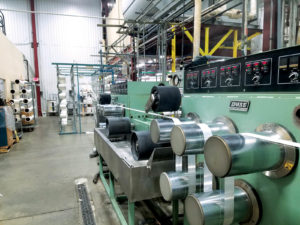
Pushing, planning and budgeting for innovation relies on creativity, construction, communication and collaboration throughout the industry.
It was a tough night for firefighters called out to three major blazes overnight. One exhausted man slogged back to the rig in his soaking-wet turnout gear. When another firefighter touched his shoulder, he screamed. It’s a steam burn—moisture in the air layer between the turnout and the firefighter’s skin becomes superheated and condenses into boiling water when he’s touched.
Such a situation ignited discussions at W.L. Gore & Associates Inc., Newark, Del. Gore product specialists, who maintain constant contact with protective clothing markets, discovered that turnout gear loses some of its fire-protective qualities when wet, and that sweaty internal environments increase risk of heat stress and steam burn.
“‘Fitness for use’ is our goal for W.L. Gore products,” says Matthew Decker, technical leader for Gore Research and Development. “We want staff to have a deep understanding of materials, product construction and user expectations.” Company staff viewed the turnout issues through these filters and saw potential solutions identified by firefighters.
A product concept form described what added value a new product could give the firefighter. These talking points are discussed and refined, inside and outside the company. “The form should pass the ‘grandma’ test. My grandma and anyone else should be able to read it,” says Decker. “You shouldn’t need technical expertise to understand how the product could provide significant improvements in end-user protection or comfort.”
Throughout the research and development process, Gore staff works closely with partners, many of whom have a stake in building a better turnout. “We license partners to use Gore products,” says Decker, “because we’re ensuring the end product’s fitness for use.” Partners design the product; Gore reviews the design to ensure that the company’s technologies work as intended. Collaboration is the name of the game, and the only way to assess the product’s value is to demonstrate the prototypes with physical testing on real firefighters.
The outcome: the GORE® PARALLON™ liner system, introduced in April 2015. Conventional turnouts lose 34 percent of their thermal protection when wet; the PARALLON liner system loses only 4 percent. The system incorporates a layer with maximum breathability close to the skin, allowing firefighters to sweat (which cools the body) without being wet (which is uncomfortable and increases potential for heat stress and steam burn).
At the April 2016 Fire Department Instructors Conference (FDIC) International, Gore presented the results of a third-party study confirming the PARALLON liner system’s highest breathability in the turnout market. Gore’s licensees and partners should see the first turnouts with PARALLON liner systems in firefighters’ lockers this year.
PARALLON is only one product out of many emerging from Gore’s ongoing innovation journey. Emerging issues for fire and public safety officials include household chemicals, designer drugs, terrorism threats and human blood-borne pathogens, as well as shifting government standards and test methods. Chances are good that turnout gear will go through other evolutions.
There are other reasons for W.L. Gore’s continuing success: it’s a great place to work. Gore has been in Fortune magazine’s annual compendium of “100 Best Companies to Work for®” each of the past 20 years. “Lots of us wear Gore outdoor products, and we’re not big on titles,” Decker says. “We’re big on people who are passionate about our company and are always out there looking for unmet demand and opportunity.”
Evolution and revolution
Simply put, manufacturing innovation translates an idea into a product or service that creates value. That increased value must be replicable at a reasonable cost, satisfy a specific need and be significant to the customer.
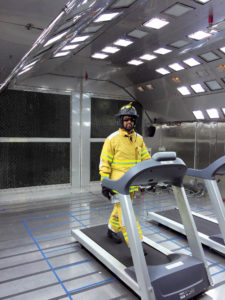
Innovations can be evolutionary (continuous improvements) or revolutionary (new products that create new markets, disrupt the status quo and involve significant risk). Manufacturers must decide how to balance resources and assess potential risks; easy to say, hard to do. But innovation is essential to manufacturing growth, reports professional service network PwC in its “Global Innovation Survey 2013.”
“Most companies are still innovating in incremental ways that are safe, profitable and important for their growth,” PwC reports. “Things get more interesting when we look at the companies who are taking a more comprehensive approach to innovation. The least innovative group of industrial manufacturing companies only generated 7.1 percent of their revenues from new products and services launched in the last year, while the top innovators managed a revenue boost of 22.8 percent.”
Drivers of innovation include customer feedback; employee observation and inspiration; new scientific or technology research; availability of raw materials; partnerships with academic, government or business innovation centers; market trends and demographics; regulations and trade policies. How does a business manage?
We asked leaders in innovative companies producing fibers, fabrics, materials and equipment to describe how they keep new products and services coming for industry manufacturers. Strategies vary, but common threads emerge.
Top managers push, plan and budget for innovation. Research and development teams scan the horizon for what’s new, what’s next and what fits with the company’s values and goals. And innovative cultures are built by “talking up a storm,” freely swapping ideas inside the company, venturing outside the company to collect intel, and communicating early and often with customers.
Innovation as a family value
Forces that spawn innovation can include something as basic as distinctly articulated family values. Milliken & Co., a global textile technology leader based in Spartanburg, S.C., emphasizes a proud 152-year history of innovation, represented by more than 2,200 U.S. patents and more than 5,000 patents worldwide. “Meaningful design. Unique insights. Deep science,” reflects Milliken’s commitment to finding “creative ways to enhance people’s lives and make the world around us easier, safer, more sustainable and more beautiful.” Not coincidentally, the company has been recognized by the Ethisphere Institute as a “World’s Most Ethical Company®” every year since the award was first given in 2007.
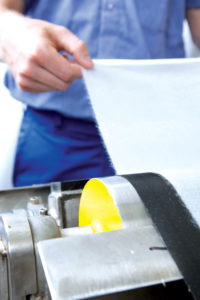
Dr. Emily Michaels, research manager for Milliken Engineered Performance Products, says “We want something that is better. Better for the customer, the environment and the world.” Michaels and LeAnne Flack, new business development manager, note that market research shows that consumers are more discerning than ever before about performance features and the environmental impacts of materials used in residential furnishings. Milliken has a successful line of fabrics for commercial interiors, but hasn’t yet moved into the residential market.
Recent data has elevated concerns about exposure to perfluorinated chemicals (PFCs), which provide stain resistance and water repellency to fabrics used in commercial settings, where exposures are minimal and insults (stains, spills and wear) are great. However, people use their home furnishings like gypsies—eating, drinking, napping, playing, cuddling and working, day and night. Would more discerning consumers prefer residential fabrics without PFCs?
“In many ways, Breathe by Milliken™ is a great example of who we are and what we do,” says David Smith, vice president of Milliken’s Engineered Performance Products. “It provides top-notch protection and is the ultimate family-friendly solution, in keeping with the Milliken brand.”
The new line of unique, “eco-elegant” performance fabrics is designed to reflect today’s relaxed lifestyles and environmental consciousness. The industry’s first fluorine-free performance fabrics, Breathe includes features that are compatible with natural, synthetic and recycled fibers. A proprietary plant-based water-repellent delivers performance features without PFCs. The fabrics are soft, beautiful, durable, water- and stain-repellent and easily cleanable—while attaining GREENGUARD® Gold certification for meeting the most rigorous environmental standards.
According to Smith, the company’s major innovation driver is the Milliken culture and legacy: vision and values, foresight, stretch goals, empowerment, communication and recognition. Conversations among the business and R&D staff take place informally, in routine meetings, at annual “grown-up science fairs” on relevant new research, and (of course) in the company coffee shop. “We come up with lots of great ideas in the coffee shop,” says Michaels.
The best customer is “aligned with our values, has a partnership mind-set and has the potential to be a market leader,” says Smith. Milliken formed a partnership with Pottery Barn, an upscale home furnishings and goods retailer, to integrate Breathe fabrics into its residential furnishings. Both companies emphasize the sustainable and environmentally friendly qualities of their products.
Smith ticks off the criteria for an innovation opportunity: “Is it the right business strategy? Is it the right market? Can we align with the right partner? Can we create a good solution? And do we have the right resources to implement?” He agrees that balancing resources between ongoing product improvement and breakthrough innovations can be challenging, but seems comfortable with the risks.
“I’m a realistic optimist,” Smith says. “The opportunities outweigh the risks. In this world, the greatest risk to a business’s success is doing nothing to innovate.”
Our middle name
In contrast to Milliken’s long history of innovation, Fiber Innovation Technology Inc. (FIT) was founded in 1995 by four professionals with experience at Eastman Chemicals and BASF’s Fiber Products division. The cofounders purchased world-leading technology for producing bicomponent fibers and struck out on their own.
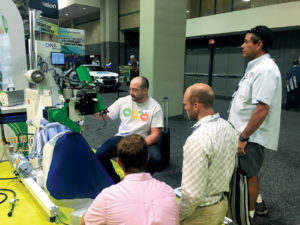
“We were at the bottom of a swoon in textile manufacturing,” says Jeff Dugan, FIT’s vice president of research. “We fit into a hole created by people getting out of research and development to focus on the near term. We opted for the future.”
FIT manufactures specialty fibers for textiles, nonwovens and thermoplastics. Its Johnson City, Tenn., facility began operation in spring 1997, with small, commercial-scale manufacturing of specialty fibers. It was a risky launch. “At first, we didn’t have many fiber sales,” says Dugan. “We had to sell the technologies to customers first.” FIT makes off-the-shelf fibers for customers who know what they need, but the company’s goal is to “be a partner with anyone who wanted to work on new fibers or applications.” One strategic decision: to develop a pilot line for testing new products, while commercial fiber production continues on the main line. The pilot line now runs five days a week, eight hours a day, and will be ramping up.
“Because we are unique—and set up for innovation—companies come here,” says Dugan. “They ask ‘Can you make a fiber that can do this?’” FIT develops a fiber solution and can test it at small scale on the pilot line. Partners with great ideas can develop and test cheaper, faster and at lower risk; the resulting fiber solution can move into commercial-scale production without missing a step. This attracts customers who downsized or eliminated R&D; FIT serves as an outsourced development lab and production partner.
Among FIT’s stand-out products are polylactic acid (PLA) fibers for NatureWorks LLC Ingeo™, made from plants like corn, cassava, sugar cane or beets. Ingeo PLA pellets are used for applications ranging from yogurt cups to baby wipes. “PLA is considered the grandfather of the whole movement to develop biopolymers from biological materials,” says Dugan.
Another product, the 4DG™ fiber modified cross-section, has an unusual shape that allows for capillary wicking, the most effective moisture transport fiber commercially available. FIT has been the sole licensee to make the fiber, and applications in moisture management, thermal insulation and filtration are under consideration by partners. “The perfect customer is well-situated in his own market to exploit the innovation,” says Dugan.
With more finely focused targets and technical risks, FIT’s staff of 60 employees know that “there is something new coming around the corner every day,” says Dugan. The entire team is engaged in development projects. “Everyone is part of the success,” he says. “It keeps things interesting for employees.”
New problems, new products
Fiber manufacturers are near the top of the supply chain, which can be both rewarding and challenging. Not only do they research and develop fiber innovations, but they must convey the value all down the supply chain. No innovation is an island.

Kelheim Fibres GmbH, Kelheim, Germany, is the world’s leading producer of viscose specialty fibers. The sustainably sourced fibers, derived from wood from managed plantations, are used in hygiene products, nonwovens, fabric, flock and filtration papers, among other applications. The company is managed for innovation, because “we are all conscious that the world doesn’t stand still,” says Matthew North, commercial director. “We create an open environment that allows people the freedom to come up with ideas.”
Innovation is part of the business plan, with employees participating in idea focus groups and “Inspiration Forums,” where staff informally bounce ideas around and decide which ones should move forward. Suggestions from customers, conferences, trade shows or workshops go into an “Ideas Store,” after an interested staff member or team prepares a broad-brush description, market evaluation and cost estimates. In February 2017, Kelheim organized a competition for new ideas on “100 percent cellulose fibers—rethought” with BioCampus Straubing under the patronage of the Bavarian State Secretary for Economic Affairs.
“We have seen completely new conceptual approaches and we have gained contacts in industry sectors and application areas formerly unknown to us,” said North during the awards ceremony. Of the 20 innovative ideas proposed, the winner focused on developing viscose fibers to filter endocrine disrupters from wastewater. Because of growing concern about the impacts of endocrine disrupters in water on fish, wildlife and human health, such a breakthrough could have huge implications.
Kelheim’s perfect customer is not someone who says, “We need this fiber, period,” but instead says “We have this problem; do you have a fiber solution?” Great customers work with Kelheim on solutions, see themselves as innovators and can convey the new fiber’s added value down the supply chain to their customers. Sustainability is a big advantage; viscose is a natural polymer from a renewable source that can be composted or recycled. Kelheim’s products confer other advantages, such as flushability in wet wipes (using Viloft® short-cut fibers) or yarns with differential dye uptake (using Danufil® Deep Dye® fibers).
While researching the possibilities of conductive fiber, Kelheim developed a new fiber, Electra, that can dissipate static charges, and is currently testing potential applications to sensitive electronic components. Electra is that rare innovation, a solution without a problem—yet!
“We have to innovate to keep customers interested,” says North. “Innovation is necessary to survival.”
The right direction
In PwC’s survey, 92 percent of respondents said innovation is important to future growth, but only two-thirds reported that their company has a well-defined strategy to achieve it. John Crum, president and CEO of Seaman Corp., Wooster, Ohio, is part of that forward-thinking fraction.
Seaman has offered innovative fabric solutions involving knitting, weaving, compounding, coating, finishing, printing and fabrication for more than 65 years. “Norm Seaman, our founder, was a major driver of innovation at Seaman,” says Crum. “He, Richard Seaman [the current chairman of the board] and the rest of the family looked at polyvinylchloride (PVC), fabrics and polymers in unique ways. Over the years, upper management’s commitment to innovation has been a major catalyst for product development.”
Seaman’s five-step process:
1. Idea generation. “On the front end, we want people with passion, communication skills and a ‘bias for action and velocity,’” says Crum. Customers, vendors, universities and staff keep ideas rolling into Seaman’s Innovation and Business Development group. “We recruit creative minds to get the right people on the bus.”
2. Market research. Seaman staff meet with market experts and prospective customers to better understand what they want to do with the company’s products. “Our staff ask themselves if we can add value,” says Crum, “or whether we can solve a unique problem.” According to Crum, 80–90 percent of Seaman’s customers sell the premium product in their individual markets, so they’re always looking for innovative solutions.
3. Product development. “This is where collaboration is critical,” says Crum. “We have an open office environment designed to keep discussions going. A multi-generational staff offers different perspectives, and Ph.D. engineers, scientists and extroverts bring the customer’s ideas back from the field.”
4. Prototyping. After developing a prototype, technical staff unveil the concept to prospective customers to see if it meets expressed needs and expectations. “Approximately 30 percent of technical time is spent in the field,” says Crum. “People need to get real-life experience and see the product’s end application.”
5. Product launch. All hands are on deck when a product is launched, with a multi-pronged approach that includes customer interaction, trade shows and in-field beta testing. Ultimately, Seaman intends to promote the value of products to the end customer.
At a recent trade show, Seaman’s booth displayed XR-QuikLiner™, a recently developed technology to bond polypropylene fibers directly to a reinforced thermoplastic compound, providing waterproofing, corrosion resistance, high aesthetics and graffiti resistance. Its durability and reduced maintenance implications for infrastructure, such as water containment vaults, sound barriers and structural building products, were well received, and several potential customers offered to beta test the product. The company’s FiberTite Hybrid roofing system, meeting stringent demands for facility protection, has become a favorite of data centers, where precious digital information is stored by companies like Google, IBM, Apple and Microsoft.
Seaman has adopted Lean Sigma® for organizational efficiency, and received the 2012 Perfect Engine Award in recognition of the company’s commitment to continuous improvement. Crum agrees that keeping both evolutionary and revolutionary innovation moving can be difficult. “Management has to keep the balance, and Seaman is designed for both types of innovation,” says Crum. “With discipline and rigor, it can be done.”
Upstream, downstream
Fiber, fabric, membrane and material manufacturers work hard to convey the value of their products to distributors and fabricators. Another part of the supply chain—equipment, tool and service suppliers—fosters the same evolutionary and revolutionary innovations as those that power businesses upstream and downstream, as well as a 360-degree vision of the current landscape.
Miller Weldmaster Corp., Navarre, Ohio, pioneers industrial fabric welding solutions across the globe to handle PVC laminated and coated fabrics and films, polypropylene, polyurethane, polyethylene, nonwoven polyesters, double-wall fabrics, digital textiles, thermoplastic rubbers and more. As new materials enter the market and customer demands evolve, how does the company stay on top?
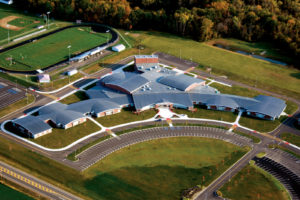
Brian Henry, vice president of international sales and packaging, is unfazed. “It all starts with people: our staff, our company and our customers,” he says. “We have field service engineers working with customers all over the world. You get the true story from customers, about what materials they use, what problems they see and what equipment technologies they need.”
Like other companies in this article, Miller Weldmaster is managed for innovation, with new product development a priority following the appointment of Jeff Sponseller as chief marketing officer in 2015. “There is a growing demand among manufacturers in many sectors for high-performance welding solutions,” says Sponseller. “Miller Weldmaster is committed to being at the forefront of innovation and equipping manufacturers with the production measures they need to markedly increase output.” Scott Miller, president of Miller Weldmaster, was given a Global Entrepreneur Award in 2012 by the Ohio chapter of The International Entrepreneur.
Feedback from customers, engineers, sales, international distributors, trade shows, associations, the shop floor and “anywhere else in the company” keeps good ideas flowing. Field service engineers clock plenty of face time with customers and come back with insights about problems and potential solutions. “Sometimes we can help the customer with prepping a new fabric to work better in the existing machinery,” says Henry. “We can tell customers other ways they can use their machinery. We can propose changes. We can find out what customers in other countries want that may not be available on standard machinery. It’s all about opening up and looking outside your walls.”
Double-wall fabrics (also called drop stitch) are constructed of dual fabric layers bonded together with thousands of polyester threads to create a single strong textile unit. Technology to weld these fabrics, often used to manufacture inflatable products, was a growing need among Miller Weldmaster’s customers. In response, the company introduced the T300 Extreme Flex Hot Air Welder, which features a specialized ultrasonic cutter, welding nozzle and fabric roller designed to reduce production time and labor costs on drop-stitch products.
Miller Weldmaster’s vision statement for 2020 includes employing lean manufacturing—doing more with less by eliminating activities that consume resources without adding value. One recent improvement, Quicksync Visual, allows certified technicians to remotely connect to most Miller Weldmaster machines via an ethernet connection and router. With the company’s integrated programmable logic controller and Quicksync Visual, staff can diagnose and troubleshoot remotely, reducing company travel costs and customers’ production downtimes.
The customer provides both the motivation and intelligence to bring great ideas into being. Brian Henry describes the perfect customer as “a partner in business, who is transparent and open with us about what they want and need. Transparency in communication is the way to succeed in innovation.”
 TEXTILES.ORG
TEXTILES.ORG


